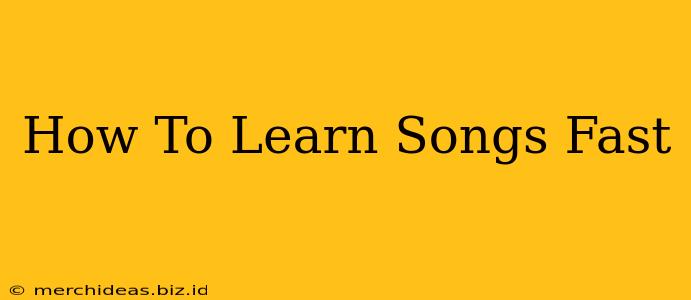Learning a new song quickly can be incredibly rewarding, whether you're a seasoned musician or just starting out. This guide provides practical strategies to accelerate your learning process, allowing you to master songs faster and more efficiently.
Understanding the Learning Process
Before diving into techniques, it's crucial to understand how we learn music. It's not just about memorizing notes; it's about internalizing the rhythm, melody, and harmony. This involves several key cognitive processes:
- Auditory Processing: Your brain deciphers the sounds, recognizing patterns and relationships between notes.
- Motor Skills: Your fingers, hands, and other playing mechanisms need to coordinate seamlessly.
- Memory: Both short-term (remembering a section just played) and long-term (remembering the entire song) memory are vital.
Effective Strategies for Fast Song Learning
Here are proven methods to boost your learning speed:
1. Break It Down: Section by Section Mastery
Instead of tackling the entire song at once, break it into smaller, manageable sections. Focus on mastering one section before moving to the next. This prevents overwhelm and allows for focused practice.
- Identify Phrases: Songs are often naturally divided into musical phrases. These are excellent units for focused practice.
- Looping: Utilize looping features on your audio player or DAW (Digital Audio Workstation) to repeatedly practice challenging sections.
2. Slow and Steady Wins the Race: The Power of Slow Practice
Practicing at a slower tempo than the original song allows for meticulous attention to detail. This helps improve accuracy and build muscle memory before increasing the speed.
- Gradual Tempo Increases: Once you've mastered a section at a slow tempo, gradually increase the speed, ensuring accuracy is maintained.
- Metronome Use: A metronome is indispensable for maintaining consistent tempo and improving rhythm.
3. Active Listening: More Than Just Hearing
Passive listening is insufficient for fast learning. Active listening involves carefully analyzing the song's structure, melody, harmony, and rhythm.
- Transcribe Sections: Transcribing short sections can significantly enhance your understanding of the song's musical elements. Even partial transcriptions are beneficial.
- Identify Key Changes: Paying close attention to key changes will make the song easier to navigate.
4. Learn the Chords First: Building a Foundation
Understanding the underlying chord progression is crucial. Learning the chords independently before tackling the melody can significantly speed up the process.
- Chord Diagrams: Use chord diagrams to visualize finger positions and chord shapes.
- Chord Progressions: Practice smoothly transitioning between chords to build fluency.
5. Practice Smart, Not Just Hard: Targeted Effort
Effective practice is targeted practice. Focus on your weaknesses rather than repeatedly playing sections you already know well.
- Identify Problem Areas: Honestly assess which parts of the song challenge you the most and dedicate more time to those areas.
- Record Yourself: Listening back to your own playing can help identify areas needing improvement.
6. Utilize Technology: Tools for Accelerated Learning
Numerous apps and software are designed to aid music learning. Consider using tools such as:
- Slow-down/Pitch-shift Software: Allows you to practice at slower tempos and altered pitches.
- Music Notation Software: Enables visual learning and analysis.
Consistency is Key: Regular Practice for Optimal Results
No matter how effective your techniques, consistent practice is non-negotiable. Even short, focused practice sessions are more beneficial than infrequent, long ones. Aim for regular, shorter sessions to build momentum and retain information effectively.
By implementing these strategies and maintaining consistent practice, you'll be amazed at how quickly you can learn new songs and enhance your musical abilities. Remember to celebrate your progress along the way and enjoy the journey of musical discovery!
